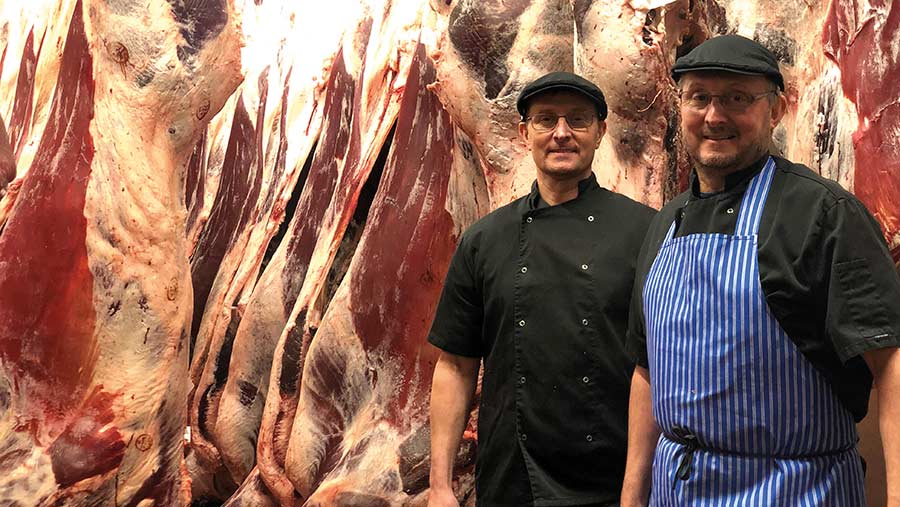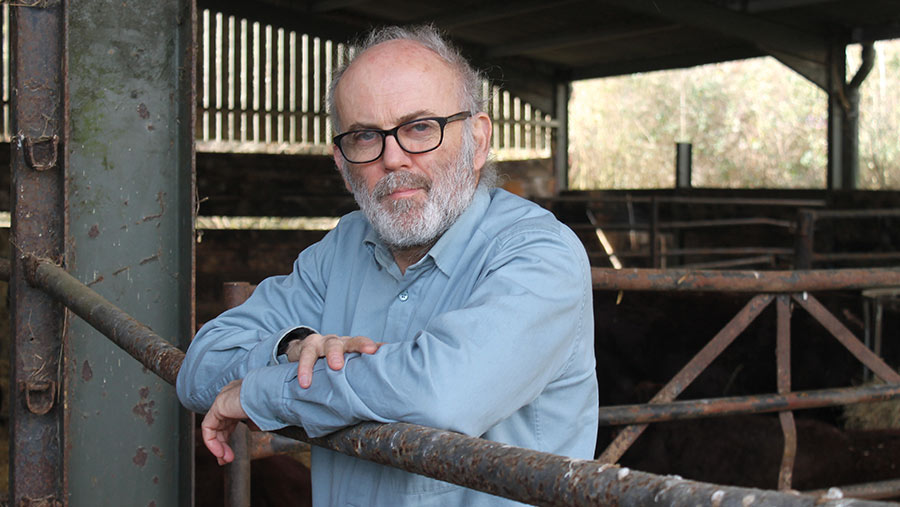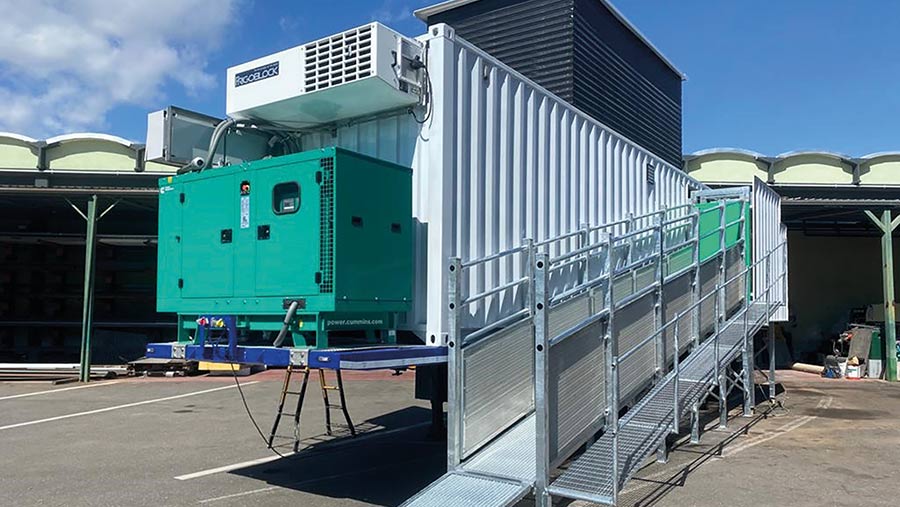Analysis: How can the small abattoir sector be saved?
 John and Steven Mettrick © Mettricks Butchers
John and Steven Mettrick © Mettricks Butchers It is estimated that only 49 small red meat abattoirs remain in England, Wales and Scotland and, if closures continue at the current rate, none will be operating by 2030.
A 2021 survey by trade body National Craft Butchers (NCB) indicated that almost 60% of abattoirs processing less than 1,000 livestock units a year would close within two to five years without intervention, and that analysis appears to be spot on.
Megan Perry, head of policy and campaigns at the Sustainable Food Trust (SFT), says 13 have been lost in the past three years alone and it is now “reaching a catastrophic situation”.
See also: Why local abattoirs are at risk and how farms are affected
Among last year’s closures was Mettrick’s abattoir in Glossop, Derbyshire, which came as a major blow to the 200 local farmers who used it.
The Tottingworth abattoir in East Sussex was another casualty in 2022 – unable to find the £100,000 needed to modernise the facility.
Regulation
One of the main reasons for these closures is the burden of regulation and inspection, with critics suggesting that it is often due to an inexperienced official veterinarian (OV).
John Mettrick, who is chairman of the Abattoir Sector Group (ASG) and legislation director of NCB, has said inexperienced vets was a significant reason behind his decision to close his abattoir last year.
How many abattoirs and their value
Small abattoirs in England killed 14,616 cattle and 11,230 sheep in 2021, according to AHDB figures, producing meat with a retail value of £53m-£58m.
This does not include pigs, or animals killed in Wales, Northern Ireland and Scotland, so the numbers and value are much higher for the UK as a whole.
Although this is a small proportion of the total herd and flock killed in the UK, it is seen as a valuable financial asset to local rural economies.
The ASG and its members have been pressing the government for an overhaul of this system, urging risk-based and proportionate regulation and inspection instead of the current “one-size-fits-all” approach.
For example, OVs must currently inspect both the live animal and the carcass, yet meat hygiene inspectors once had this job.
Flexibility
Another example is the failure of the UK government to implement the EU’s so-called “5% rule”.
Currently, operators slaughtering less than 1,000 livestock units a year – classed as “small” – only require part-time OV supervision.
But once an abattoir exceeds the 1,000 livestock units limit, they transfer to full-time OV supervision.
Without the 5% flexibility allowed in Europe, many small abattoirs elect to operate at a less than full capacity, because they don’t want to exceed that 1,000-head limit.
“The 5% rule is something the ASG has been calling for and the Food Standards Agency have said they see no reason not to allow it from a logistical, animal welfare or food hygiene point of view,” says Ms Perry.
And then there is the shortage of experienced, qualified vets.
Mr Mettrick describes this as a “recipe for disaster”, as an inexperienced vet who has only worked in large, single-species abattoirs will be “out of their depth” in a small abattoir, which has the complexity of slaughtering lots of small batches and multiple species, he says.
How abattoir closures affect farmers
One farmer, who also runs a pub and restaurant in Sussex, is calling on UK governments and regional assemblies to spend some of their farm support budgets on grants for small abattoirs, or risk losing a vital piece of the local food jigsaw.

Stephen Carr © MAG/Phil Clarke
Since the closure of the Tottingworth abattoir near Heathfield in October 2022, Farmers Weekly columnist Stephen Carr has had to travel to Henfield in West Sussex to slaughter cattle and lambs destined for his pub, the Sussex Ox, in East Sussex.
That drive can take more than an hour on often congested roads compared to the previous 25-minute journey to Tottingworth.
Mr Carr’s story of longer journeys is becoming commonplace, and it risks undermining the local provenance and low food miles message, he says.
“Local abattoirs are a crucial part of the farm-to-fork appeal, as shorter journeys emit less carbon and offer obvious animal welfare benefits.”
Small abattoirs also cater for single animal consignments and native and traditional breeds.
“These don’t really fit into the large processor model,” says Mr Carr. “Some native breeds have thick skins or long horns and these present special challenges at slaughterhouses.”
If the abattoir at Henfield closed, Mr Carr’s journey time to the next nearest plant would rise to three hours and the cost would become unsustainable.
“This is where the local food network crumbles,” he says. “We are in an endless, vicious cycle that not only affects businesses like mine, but every farm shop, every farmers’ market.”
Mr Carr wants governments in all parts of the UK to “look beyond the plain commercial aspect” of the role of local slaughtering facilities, and help them compete with larger industrial facilities.
“There is £3.3bn in the UK kitty from recycled EU subsidies to redistribute into agriculture and rural infrastructure and job creation.
“If governments are prepared to fund initiatives such as large, individual rewilding projects, it would be a small but crucial investment to provide grants to small local abattoirs for them to upgrade their equipment and subsidise some of their costs.
“They must find some money from their rural budgets for these vital facilities.”
Funding issues
In addition to the regulatory challenges, soaring costs and an absence of government help for investment in modernisation have forced many small abattoirs out of business.
The 2021 NCB survey showed that the most urgent funding requirements are for maintenance and equipment, but also for extensions, waste management and staff training.
Although the details are not yet clear, Defra farming minister Mark Spencer has said that funding will be available “later this year” to help small abattoirs invest in new technology and improve productivity and animal welfare.
The announcement, made at last week’s NFU Conference, has been warmly welcomed by the Rare Breeds Survival Trust (RBST), which has lobbied hard for greater assistance to small abattoirs.
“The sustainable livestock sector is made up largely of small farms keeping small numbers of animals, often local breeds particularly suited to their area,” says RBST chief executive Christopher Price.
“Those farms depend on the existence of a network of abattoirs capable of processing these small numbers of non-standard animals to high welfare standards and returning all the by-products, the skins and the horns, all of which have a market.
“More industrial-scale operations have proved themselves incapable of delivering on this. Hopefully, we may now see the start of real change.”
Can mobile units offer a solution?
Mobile abattoirs could help plug some of the gaps left by the closures of small abattoirs and provide a solution for many producers and retailers.
Such facilities successfully operate within tight regulatory regimes in European countries, as well as Canada, New Zealand and the US.
Used in combination with CCTV cameras and constructive government and regulatory engagement, the industry believes this model has advantages for animal welfare.

Mobile abattoir © Cogemat
One mobile slaughter unit is already in operation at Fir Farm in Gloucestershire and also at Elston Farm in Devon, but it was a lengthy process to work through the regulation.
For example, a Food Standards Agency licence is not only needed for the mobile unit itself, but for each farm using it; there is also a requirement for those farms to have certain facilities available.
Whether mobile units can be financially viable with the current business model is yet to be established, though setting up farmer hubs is one idea being explored by Fir Farm – for the unit to be sited in one location with local farmers travelling to it.
In 2020, the Scottish government also commissioned a study looking at the economics and sustainability of mobile abattoirs.
This showed the capital cost associated with this model was, at that time, more than £800,000.
The challenge from the absence of local slaughtering services in Scotland is particularly acute, especially so in the Highlands and Islands.
